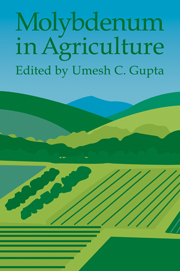Book contents
- Frontmatter
- Contents
- List of contributors
- Preface
- 1 Introduction
- 2 Chemistry and Mineralogy of Molybdenum in Soils
- 3 Distribution and Mobility of Molybdenum in the Terrestrial Environment
- 4 Biochemical Significance of Molybdenum in Crop Plants
- 5 Soil and Plant Factors Affecting Molybdenum Uptake by Plants
- 6 Analytical Techniques for Molybdenum Determination in Plants and Soils
- 7 Testing for Molybdenum Availability in Soils
- 8 Molybdenum Availability in Alkaline Soils
- 9 Deficient, Sufficient, and Toxic Concentrations of Molybdenum in Crops
- 10 Symptoms of Molybdenum Deficiency and Toxicity in Crops
- 11 Sources and Methods for Molybdenum Fertilization of Crops
- 12 Yield Responses to Molybdenum by Field and Horticultural Crops
- 13 Responses of Forage Legumes and Grasses to Molybdenum
- 14 Molybdenum and Sulfur Relationships in Plants
- 15 Molybdenum in the Tropics
- Index
7 - Testing for Molybdenum Availability in Soils
Published online by Cambridge University Press: 10 December 2009
- Frontmatter
- Contents
- List of contributors
- Preface
- 1 Introduction
- 2 Chemistry and Mineralogy of Molybdenum in Soils
- 3 Distribution and Mobility of Molybdenum in the Terrestrial Environment
- 4 Biochemical Significance of Molybdenum in Crop Plants
- 5 Soil and Plant Factors Affecting Molybdenum Uptake by Plants
- 6 Analytical Techniques for Molybdenum Determination in Plants and Soils
- 7 Testing for Molybdenum Availability in Soils
- 8 Molybdenum Availability in Alkaline Soils
- 9 Deficient, Sufficient, and Toxic Concentrations of Molybdenum in Crops
- 10 Symptoms of Molybdenum Deficiency and Toxicity in Crops
- 11 Sources and Methods for Molybdenum Fertilization of Crops
- 12 Yield Responses to Molybdenum by Field and Horticultural Crops
- 13 Responses of Forage Legumes and Grasses to Molybdenum
- 14 Molybdenum and Sulfur Relationships in Plants
- 15 Molybdenum in the Tropics
- Index
Summary
Introduction
The testing of soils for molybdenum (Mo) and other micronutrients has been reviewed extensively in recent publications (Gupta and Lipsett, 1981; Anderson and Mortvedt, 1982; Cox, 1987; Johnson and Fixen, 1990; Sims and Johnson, 1991; Sims, 1996). The general objectives for testing soils for any nutrient have been to assess the soil's capacity to supply plant-available nutrient during the growth of crops and to gather data that can guide producers in obtaining the best economic response to fertilizer application. Fitts and Nelson (1956) suggested that soil testing can be divided into four phases: (1) sampling the soil, (2) conducting tests to determine nutrient availability, (3) calibrating test findings with crop responses, and (4) interpreting the findings and making recommendations.
Because of the relatively small amounts of Mo in soils (0.1–30mg kg–1) (Kubota, 1976), the importance of seed Mo reserves in supplying crop needs (Peterson and Purvis, 1961; Harris, Parker, and Johnson, 1965; Gurley and Giddens, 1969), the importance of soil properties that affect Mo availability (Lowe and Massey, 1965; Massey, Lowe, and Bailey, 1967; Karimian and Cox, 1978,1979; Burmester, Adams, and Odom, 1988), and the low requirements of most crops for Mo (0.1–0.5 mg kg–1 tissue), the testing of soils for Mo in the classic sense is rendered difficult.
- Type
- Chapter
- Information
- Molybdenum in Agriculture , pp. 111 - 130Publisher: Cambridge University PressPrint publication year: 1997
- 4
- Cited by



